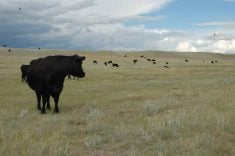NEVADA, Iowa – In Iowa corn country, Wyoming coal fires an ethanol plant that fuels California cars and feeds Mexican cattle.
At first the idea of coal-fired ethanol production from corn might seem environmentally questionable. But when properly done, the system is as greenhouse gas efficient as any other grain alcohol facility, say officials at Lincolnway Energy.
The overall contribution to greenhouse gases from a four-year-old ethanol plant near Nevada is as low as any in North America and lower than older facilities.
Read Also

Volatile temperatures expected for this winter
DTN is forecasting a lot of temperature variability in the Canadian Prairies this winter. Precipitation should be close to average.
“We don’t emit or waste anything we can avoid,” said Lincolnway production manager Dan Matlick.
“And for this year we’re adding a (carbon dioxide) capture system. We’re going to sell it to (a meat packing business) for their refrigeration system,” he said about the 135,000 tonnes of carbon dioxide produced each year.
Lincolnway is located in corn and soybean country north of Des Moines, Iowa. It’s a publicly regulated, privately held company built by local investors looking to take part in the federally subsidized American ethanol industry.
Most of the 1,300 tonnes of corn the plant uses daily is bought from local farmers and the nearby farmer grain co-op elevator.
The company’s elevator holds a 10 day supply of grain, about 500,000 bushels. It buys about 20 million bushels of local corn each year.
Each kernel is split three ways at Lincolnway, one third ethanol, one third dried distillers grain and one third carbon dioxide. Matlick said all are accounted for.
As well, he said the one million litres of water the company returns to the local municipality of Nevada is cleaner than it was when the utility delivered it to them.
The plant consumes about 1.4 million litres per day, or about two litres for each litre of ethanol Lincolnway makes.
High quality water is needed to mix with corn and yeast to make the beer, it is also turned into steam to fire the plant, said Lincolnway energy centre operator Sarah Haugen.
“We have to remove the iron that is in it when it arrives,” she said. “We test it at every stage. We test everything.”
To fire the boilers that drive the big distillery, the company relies on 86,000 tonnes annually of Wyoming Powder River Basin, low sulfur coal.
Coal is burned in a fluidized sand bed at 930 C, releasing mainly carbon dioxide.
The ash is sold for use in the concrete industry.
Lincolnway is located on the Union Pacific main rail line that runs west to Wyoming and California.
Matlick said the choice of site for the plant was based on the line.
“Even that is efficient. It also means we can cheaply export ethanol and (dried distillers grain) to California and Mexico,” he said.
Corn is fermented for two days in four 2.7 million litre fermenters. Water is extracted after that for reuse and 180 proof ethanol is pulled off.
It is later filtered by tiny ceramic balls to get the last of the water out, leaving it 200 proof or 99.2 percent pure grain alcohol.
A small amount of gasoline is then added to the 200 million litres produced annually, so nobody can sell or consume any of the liquor on its way to gas stations.
The remaining third of the production is livestock feed, dried distillers grain, and small amounts of corn oil and a molasses-like corn syrup.
Most of the DDG goes to Mexican feedlots, while the syrup is marketed regionally in the Midwest.
The 2,700 tonnes of corn oil were being sold for biodiesel production at about $425 per tonne, but the drop in U.S. federal subsidies in January has injured that market.
“It is a very small part of the business, but you want every part,” he said.
The highly automated plant operates with four staff looking after the systems. The other 40 staff ensure that grain and other products keep flowing through the facility, and provide administration.
Despite its efficiencies and more than $110 million US in sales in 2009, the company ran a five percent loss that year after posting significant profits in its first three years of operation.
The company told shareholders in its 2009 statement that tough times in the ethanol industry were to blame.
A global slowdown, lower fuel prices and relatively high costs for grain contributed to a $5.7 million operating income loss in 2009.
During 2009, the company received about 44 cents per litre for its ethanol and $170 per tonne for its DDG.
From 2008, prices for ethanol fell 26 percent per litre and DDG returns were down 15.6 percent per tonne.
Depending on a year’s commodity prices, 60 to 70 percent of the cost of ethanol and DDG production comes from corn.
To help improve profitability, the company plans to look at corn quality factors for making liquor.
“If it’s yellow and in good condition, not full of disease, we buy it all for the same price,” said Matlick.
The company is also looking at drying out its steam and boosting heat and water recovery to cut costs.
Other areas it told shareholders it sees as potential ethanol cost savers are introducing biomass, in the form of corn stover and cobs, into its system for ethanol or to replace coal.














